Will this be Forest’s season? Since 2011, not a season has gone by at Nottingham Forest in which the manager in charge at the start of the season has been the same manager who has finished it. The routine consequences of employing 13 permanent managers in an eight-year period could be predicted by most: a muddled squad acquired for multiple different blueprints, and little sense of a tactical identity. Even the summer sacking of Martin O’Neill and same-day appointment of his successor came with a side dish of chaos given that the decision was made as late as June 28th, precisely one day before Forest’s first pre-season friendly. The current incumbent of one of the hottest seats in football management, Sabri Lamouchi, has been handed a one-year contract and the same remit as his predecessors: finish in the top six or else. Not only did Lamouchi have less than 24 hours before selecting his first XI as the new head coach, he also had to contend with choosing from a squad that had become severely bloated and contained as many as 39 professionals. Probably with the length of contract in mind and with the blessing of those above him, he swiftly chose a group of players to work with and cast aside the remainder, instructing the players not in his plans to train at a separate time from his desired group and to seek transfers away from the club. All of this is relevant because it’s under those circumstances that Forest have returned a W4-D3-L1 record from their opening eight league games to leave them sitting in 6th; their sole defeat coming on the opening day against West Brom, while trips to Leeds, Swansea and Fulham, as difficult as they come in the Championship, returning seven points. What is a tricky start to the season by any measure has led to a platform for the East Midlands club to build upon and a sense of optimism is now quietly brewing in those parts.
A Clear Impact
Lamouchi must be as clear-cut and concise in his coaching as he has been in making those off-pitch decisions. There are already transparent patterns in Forest’s play both on and off the ball. They’ve settled into a 4-1-4-1 or 4-4-1-1 with the playing principles remaining largely identical in either shape, the only real difference being the use of a single or double pivot to anchor the midfield. It’s their work out of possession where Forest have really caught the eye so far. There’s already a clear impression of Forest’s organisation in their press, often sitting in and allowing the opposition to come onto them up to the halfway line but, almost like a switch gets flicked, launch into a much more aggressive and intense effort to win the ball back once the opposition build into Forest territory. 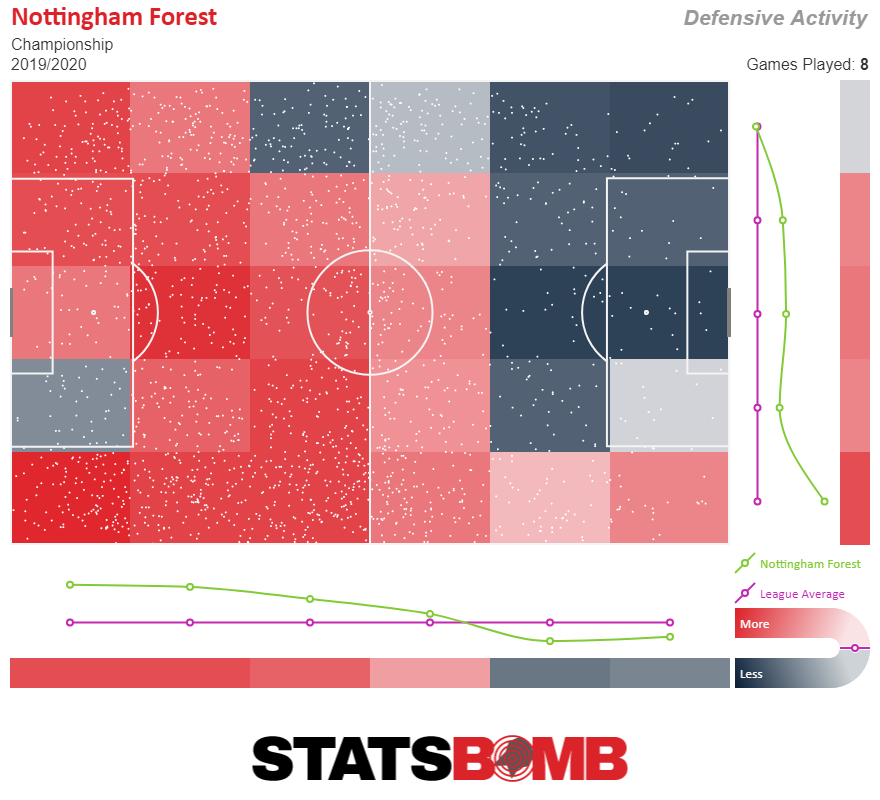 The formation naturally lends itself to this approach given the lack of forwards available to press the centre backs but also the coverage it has in both central and wide areas. The three central midfielders work with cohesion to execute the press when the ball gets moved through the central channels, whilst the wide men are equally important in their contribution to locking down the flanks. Forest’s wingers are regularly seen doubling up with their full back in an effort to successfully turn possession over or at least force the opponent to play the ball backwards. Their defensive organisation is not only compelling to watch though, it also turns up some intriguing trends in the data. First of all, Forest are rock bottom in the Championship for Defensive Distance – the average distance from a team’s own goal that it performs defensive actions – with the scarcity with which they’ll defend from the front showing clearly in this metric. They perform defensive actions closer to their own goal than any other team in the league.
The formation naturally lends itself to this approach given the lack of forwards available to press the centre backs but also the coverage it has in both central and wide areas. The three central midfielders work with cohesion to execute the press when the ball gets moved through the central channels, whilst the wide men are equally important in their contribution to locking down the flanks. Forest’s wingers are regularly seen doubling up with their full back in an effort to successfully turn possession over or at least force the opponent to play the ball backwards. Their defensive organisation is not only compelling to watch though, it also turns up some intriguing trends in the data. First of all, Forest are rock bottom in the Championship for Defensive Distance – the average distance from a team’s own goal that it performs defensive actions – with the scarcity with which they’ll defend from the front showing clearly in this metric. They perform defensive actions closer to their own goal than any other team in the league. 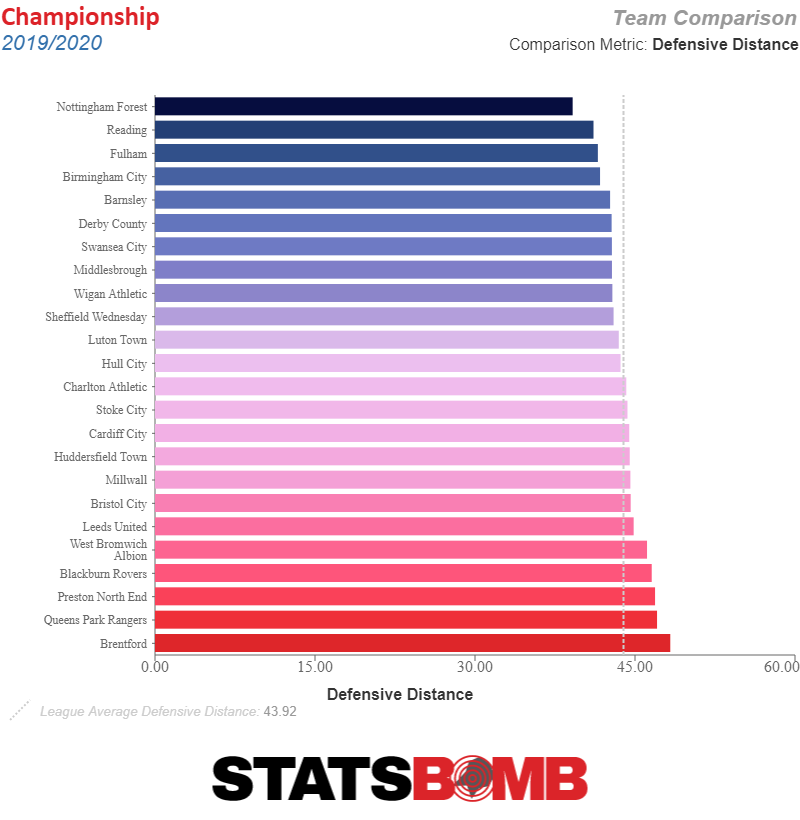 As you might expect of a side so keen to engage and disrupt the opposition when in their defensive third, Forest are also successfully limiting the quality of chances their opponents are able to create. They’re actually around mid-table for the amount of shots they’ve conceded so far – a shade over 12 per game – but the quality of those has been quelled and the average expected conversion rate of the chances they’re allowing is just seven percent, which is third best in their league. If we look at the distribution of those shots, we can see more clearly how they’ve kept this figure down. The Reds simply don’t concede clear cut chances. In eight games they’ve conceded a mere six opportunities that have an expected conversion rate of 20% or higher. If I remind you again that they’ve already played away at Leeds, whose dominance has already been covered on this site, and recently relegated Fulham, who boast a front three that are arguably the cream of the division in Ivan Cavaleiro, Aleksandar Mitrović and Anthony Knockaert, then it becomes even more impressive.
As you might expect of a side so keen to engage and disrupt the opposition when in their defensive third, Forest are also successfully limiting the quality of chances their opponents are able to create. They’re actually around mid-table for the amount of shots they’ve conceded so far – a shade over 12 per game – but the quality of those has been quelled and the average expected conversion rate of the chances they’re allowing is just seven percent, which is third best in their league. If we look at the distribution of those shots, we can see more clearly how they’ve kept this figure down. The Reds simply don’t concede clear cut chances. In eight games they’ve conceded a mere six opportunities that have an expected conversion rate of 20% or higher. If I remind you again that they’ve already played away at Leeds, whose dominance has already been covered on this site, and recently relegated Fulham, who boast a front three that are arguably the cream of the division in Ivan Cavaleiro, Aleksandar Mitrović and Anthony Knockaert, then it becomes even more impressive. 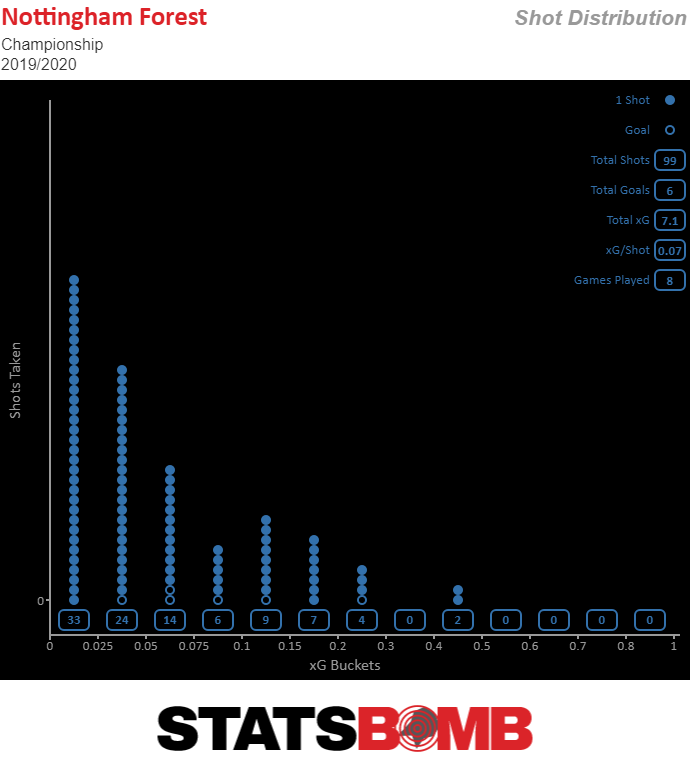 It sounds like management-speak to say that the star performer of Forest’s season so far has been the team, but it is largely true. Two of the more impressive individuals though have been in central midfield with Ben Watson, enjoying a late-career resurgence, receiving plaudits for his all-round game and intelligence in locking down the central area in front of his defence, and summer signing Samba Sow who’s really embodied what Lamouchi’s Reds are about. Sow, once he’s identified his target, has the defensive approach akin to that of a homing missile.
It sounds like management-speak to say that the star performer of Forest’s season so far has been the team, but it is largely true. Two of the more impressive individuals though have been in central midfield with Ben Watson, enjoying a late-career resurgence, receiving plaudits for his all-round game and intelligence in locking down the central area in front of his defence, and summer signing Samba Sow who’s really embodied what Lamouchi’s Reds are about. Sow, once he’s identified his target, has the defensive approach akin to that of a homing missile. 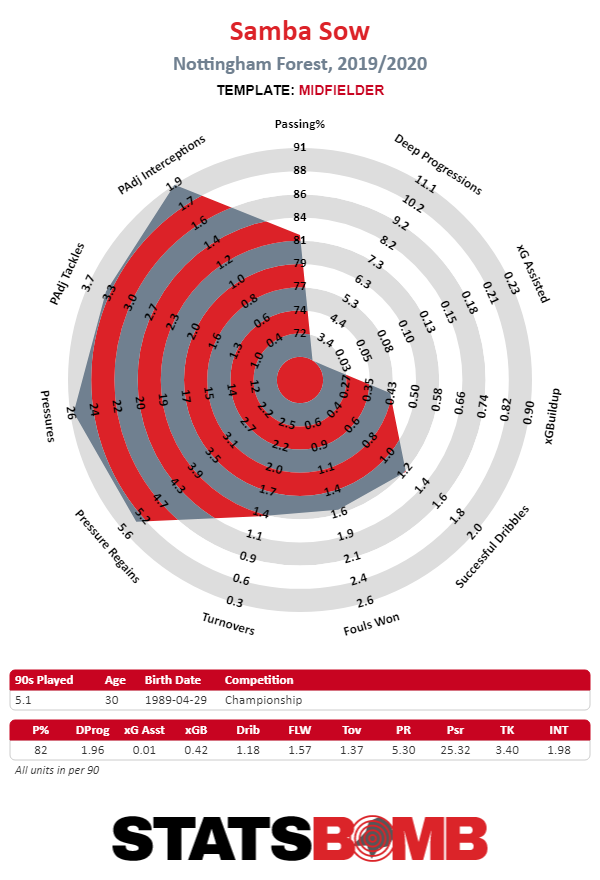 It’s clear that Forest’s best work comes when not in possession of the ball and their work in this area offers them a strong base to build from. What will be interesting is how well they can maintain their success if they continue to do well and start coming up against teams that are as happy to sit in as they are. They should be reassured that Lamouchi’s work on the training ground isn’t just limited to making them a cohesive unit without the ball as they’ve seemingly been putting the hours in to make them proficient at set plays too, a factor that could prove decisive in matches that are closely fought. Currently the Reds have created 0.36 xG per game from set play situations whilst conceding just 0.11 xG per game at the other end, figures that are both top four compared against their league rivals. Slightly less impressive is their output at the attacking end of the pitch, but it’s fair to argue that matters less when a) they’re keeping it locked down on the defensive end and b) they’ve had a tough schedule and Lamouchi isn’t a miracle worker. The amount of shots Forest take per game (a shade under 12) is much closer to league average and it’s a similar story with the amount of Expected Goals they’ve created, which is currently ninth highest in the league. They’re quite happy getting forward by playing through the thirds or by transitioning quickly on the counter attack but one clear trend to their attacking play is their proclivity to move the ball out wide as their primary means of creating chances: their Box Cross % - the percentage of penalty box entries that originate from a cross - is 34%, a figure that is joint sixth highest in England’s second tier. Not only tenacious in his protection of the backline, Watson’s importance again comes to the fore when watching how Forest build their attacks. He often drops in to receive the ball from centre halves Michael Dawson or Joe Worrall, both products of the Reds’ youth academy albeit in different eras. The experienced midfielder then looks to circulate the play and waits for the right time to progress the ball to a more creative outlet within the Forest side, something clearly visible when looking at Watson’s passes that originate from his own half, often moving the ball out wide or into one of his midfield partners who’ve moved beyond the opposition’s midfield line.
It’s clear that Forest’s best work comes when not in possession of the ball and their work in this area offers them a strong base to build from. What will be interesting is how well they can maintain their success if they continue to do well and start coming up against teams that are as happy to sit in as they are. They should be reassured that Lamouchi’s work on the training ground isn’t just limited to making them a cohesive unit without the ball as they’ve seemingly been putting the hours in to make them proficient at set plays too, a factor that could prove decisive in matches that are closely fought. Currently the Reds have created 0.36 xG per game from set play situations whilst conceding just 0.11 xG per game at the other end, figures that are both top four compared against their league rivals. Slightly less impressive is their output at the attacking end of the pitch, but it’s fair to argue that matters less when a) they’re keeping it locked down on the defensive end and b) they’ve had a tough schedule and Lamouchi isn’t a miracle worker. The amount of shots Forest take per game (a shade under 12) is much closer to league average and it’s a similar story with the amount of Expected Goals they’ve created, which is currently ninth highest in the league. They’re quite happy getting forward by playing through the thirds or by transitioning quickly on the counter attack but one clear trend to their attacking play is their proclivity to move the ball out wide as their primary means of creating chances: their Box Cross % - the percentage of penalty box entries that originate from a cross - is 34%, a figure that is joint sixth highest in England’s second tier. Not only tenacious in his protection of the backline, Watson’s importance again comes to the fore when watching how Forest build their attacks. He often drops in to receive the ball from centre halves Michael Dawson or Joe Worrall, both products of the Reds’ youth academy albeit in different eras. The experienced midfielder then looks to circulate the play and waits for the right time to progress the ball to a more creative outlet within the Forest side, something clearly visible when looking at Watson’s passes that originate from his own half, often moving the ball out wide or into one of his midfield partners who’ve moved beyond the opposition’s midfield line. 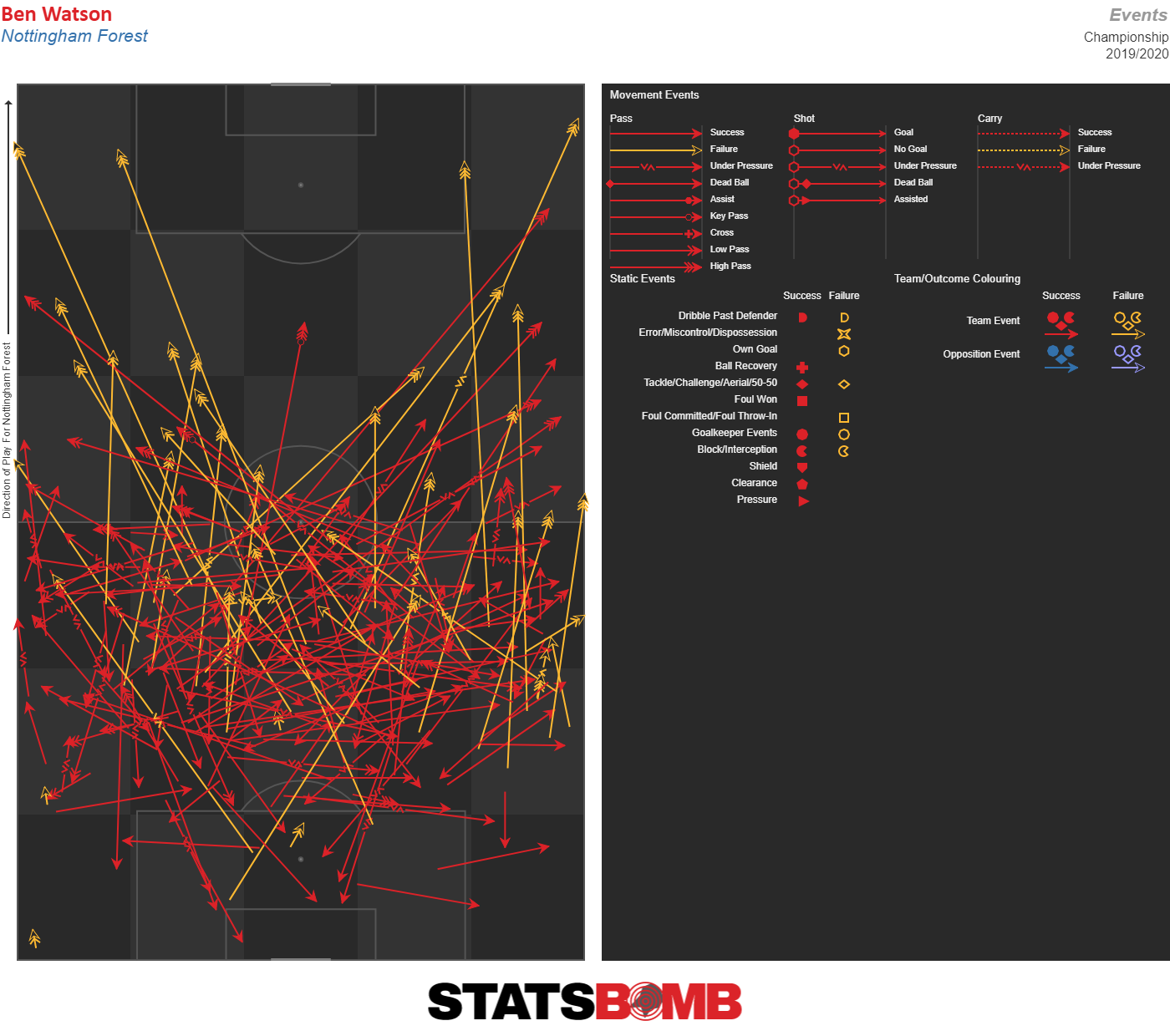 Watson works mostly in deeper areas but further forward it’s Joe Lolley, responsible for 22 combined goals and assists last season, who’s probably most important to Forest’s ability to get into the final third and in creating chances once they’re there, though the burden on him to produce decisive moments in the final third appears to have lessened this season. A member of England’s university and semi-professional teams before he made his breakthrough into the professional game, Lolley is constant in his desire to pick up the ball and drive up the right flank and has so far completed 87% of his dribbles and carries that end in the opposition half in his eight league appearances.
Watson works mostly in deeper areas but further forward it’s Joe Lolley, responsible for 22 combined goals and assists last season, who’s probably most important to Forest’s ability to get into the final third and in creating chances once they’re there, though the burden on him to produce decisive moments in the final third appears to have lessened this season. A member of England’s university and semi-professional teams before he made his breakthrough into the professional game, Lolley is constant in his desire to pick up the ball and drive up the right flank and has so far completed 87% of his dribbles and carries that end in the opposition half in his eight league appearances. 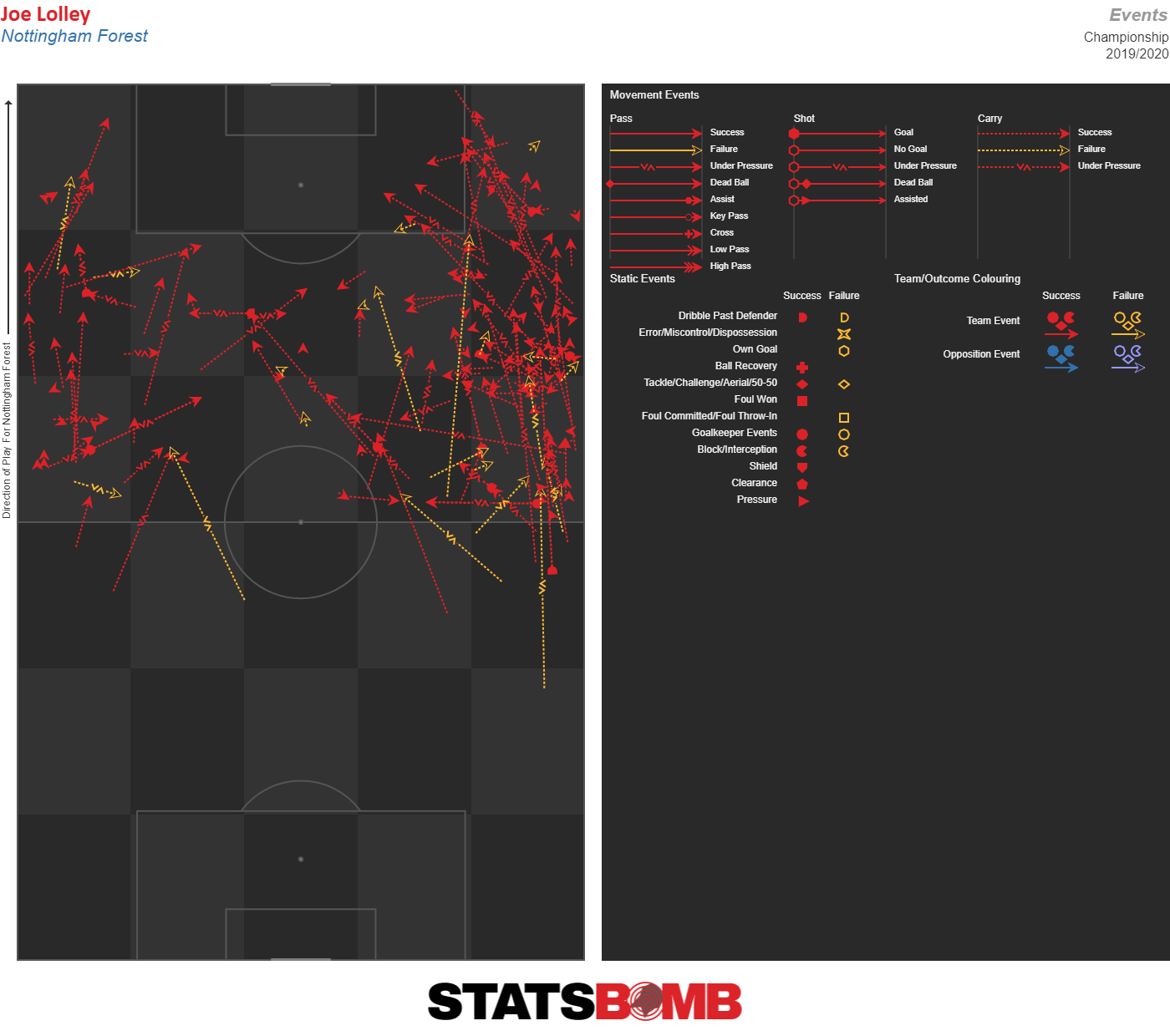 Experienced Championship campaigner Lewis Grabban has played every minute up front in the league and will be relied upon to provide clinical finishing to the end of Forest’s attacking moves if they’re to succeed this season, with their defensive base providing what should be a solid platform to pick results up from, if they maintain this level of performance. All in, it’s a promising start for the Tricky Trees with Sabri Lamouchi making a compelling early case to be the first manager for eight seasons to stay in the Forest managerial hotseat from season’s start to season’s end. But it’s top six or else.
Experienced Championship campaigner Lewis Grabban has played every minute up front in the league and will be relied upon to provide clinical finishing to the end of Forest’s attacking moves if they’re to succeed this season, with their defensive base providing what should be a solid platform to pick results up from, if they maintain this level of performance. All in, it’s a promising start for the Tricky Trees with Sabri Lamouchi making a compelling early case to be the first manager for eight seasons to stay in the Forest managerial hotseat from season’s start to season’s end. But it’s top six or else.
